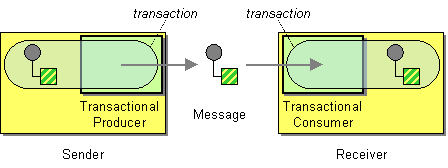Fuse 6 is no longer supported
As of February 2025, Red Hat Fuse 6 is no longer supported. If you are using Fuse 6, please upgrade to Red Hat build of Apache Camel.10.9. Transactional Client
Overview
Copy linkLink copied to clipboard!
The transactional client pattern, shown in Figure 10.7, “Transactional Client Pattern”, refers to messaging endpoints that can participate in a transaction. Apache Camel supports transactions using Spring transaction management.
Figure 10.7. Transactional Client Pattern
Transaction oriented endpoints
Copy linkLink copied to clipboard!
Not all Apache Camel endpoints support transactions. Those that do are called transaction oriented endpoints (or TOEs). For example, both the JMS component and the ActiveMQ component support transactions.
To enable transactions on a component, you must perform the appropriate initialization before adding the component to the
CamelContext. This entails writing code to initialize your transactional components explicitly.
References
Copy linkLink copied to clipboard!
The details of configuring transactions in Apache Camel are beyond the scope of this guide. For full details of how to use transactions, see the Apache Camel Transaction Guide.
